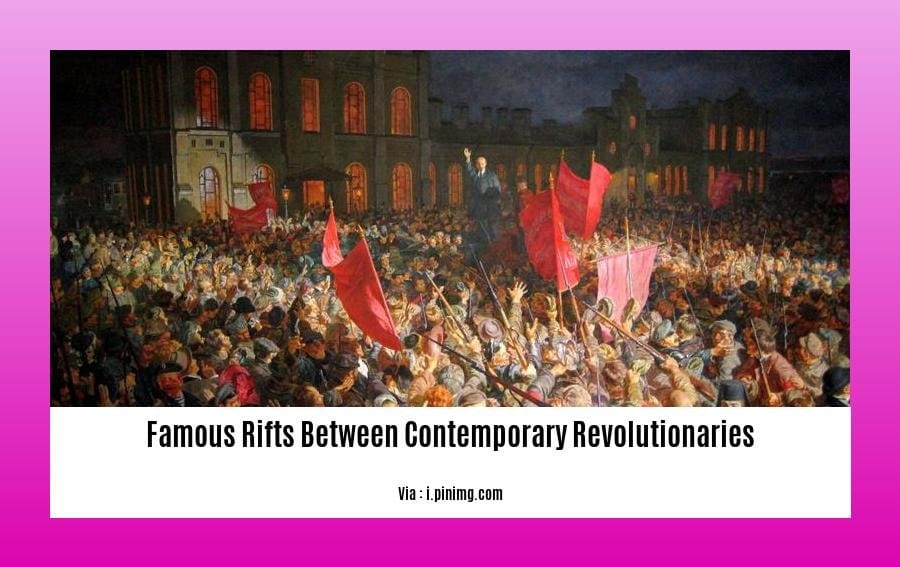Prepare to delve into the captivating world of “Famous Rifts Between Contemporary Revolutionaries: Exploring the Human Dynamics Behind Divisive Splits.” This insightful piece embarks on an enthralling investigation of the intricate human dynamics that have fueled some of the most notable schisms within revolutionary movements in recent history.

Key Takeaways:
- Revolutions in the modern world encompass diverse individuals and movements seeking transformative change.
- Contemporary revolutions prioritize social and political issues over economic or religious concerns.
- Technological advancements have revolutionized tactics and forms of revolution.
- Revolutions possess disruptive and transformative potential, while also fostering progress.
Famous Rifts Between Contemporary Revolutionaries
Rifts are a natural part of any movement, and revolutionary movements are no exception. When people with different backgrounds, beliefs, and goals come together, there’s always the potential for conflict.
Causes of Rifts Among Contemporary Revolutionaries
There are many different factors that can cause rifts among contemporary revolutionaries. Some of the most common include:
- Differences in ideology: Different revolutionaries may have different visions for the future of their country or society. This can lead to disagreements over the best way to achieve their goals.
- Personal conflicts: Rifts can also be caused by personal conflicts between revolutionaries. These conflicts may be based on personality differences, disagreements over tactics, or even personal grudges.
- External pressure: Sometimes, outside forces can put pressure on revolutionary movements, causing them to split. This pressure may come from government repression, foreign intervention, or even public opinion.
Consequences of Rifts
Rifts can have a significant impact on revolutionary movements. They can divide the movement, making it less effective and more vulnerable to attack. They can also lead to violence and bloodshed.
In some cases, however, rifts can also be a positive force. They can force revolutionaries to re-examine their goals and strategies. They can also lead to the emergence of new leaders and new ideas.
Examples of Rifts Among Contemporary Revolutionaries
There have been many famous rifts between contemporary revolutionaries. Some of the most notable include:
- The split between the Bolsheviks and Mensheviks in the Russian Revolution
- The split between the Maoists and Dengists in the Chinese Revolution
- The split between the FARC and ELN in the Colombian Revolution
- The split between the ISIS and Al-Qaeda in the Syrian Civil War
These rifts have had a significant impact on the course of history. They have helped to shape the world we live in today.
Conclusion
Rifts are a natural part of any movement, and revolutionary movements are no exception. These rifts can have a significant impact on the movement, both positive and negative. By understanding the causes and consequences of rifts, we can better understand the challenges that revolutionary movements face.
-
Delve deeper into the revolutionary peers and their intense rivalries that fueled the revolutions.
-
Uncover the feuding revolutionary counterparts and contemporaries and their battles for power and influence.
-
Explore the rivalries that shaped revolutions and the impact they had on the course of history.
Pol Pot and Son Sen: The Khmer Rouge Purge
When brutality fuels a revolution, the victims are not just those who fall before the firing squads but also the revolutionaries themselves. Pol Pot and Son Sen, two of the most notorious figures in the Khmer Rouge regime, exemplified this tragic reality.
Son Sen, a close confidant of Pol Pot, gradually rose through the ranks to become Minister of Defense. His loyalty was unquestioned until he dared to question the regime’s agricultural policies.
Like a venomous snake, Pol Pot turned on his former comrade, accusing him of treason and orchestrating a purge that claimed up to 10,000 lives, including Sen’s own.
Key Takeaways:
- The Khmer Rouge purge was a systematic campaign of violence targeting political opponents and intellectuals.
- Son Sen, once a high-ranking Khmer Rouge official, was executed after questioning Pol Pot’s policies.
- The purge weakened the Khmer Rouge, contributing to its eventual defeat.
Citation:
Fidel Castro and Che Guevara: The Cuban Revolution Divided
Revolutionary movements, so often born from a shared desire for change, can face the harsh reality of internal divisions. The Cuban Revolution, led by Fidel Castro and Che Guevara, is a prime example of how even the most seemingly unified movements can be torn apart by ideological differences and personal conflicts.
The seeds of division
Castro and Guevara were initially united by their Marxist-Leninist beliefs and their shared goal of overthrowing the U.S.-backed dictatorship of Fulgencio Batista. However, as the revolution progressed, their differing visions for Cuba’s future became increasingly apparent. Castro favored a more pragmatic approach, prioritizing economic stability and diplomatic relations with the Soviet Union. Guevara, on the other hand, remained a staunch idealist, advocating for a more radical socialist transformation of Cuban society.
Personal conflicts
Beyond ideological differences, personal conflicts also played a role in the rift between Castro and Guevara. Guevara’s charisma and popularity among the Cuban people threatened Castro’s authority, leading to feelings of jealousy and resentment. Furthermore, Guevara’s outspoken criticism of Castro’s policies further strained their relationship.
The break
The final break between Castro and Guevara came in 1965 when Guevara left Cuba to continue his revolutionary activities in other parts of the world. Guevara’s departure symbolized the growing divide within the Cuban leadership and left a lasting legacy of division within the revolutionary movement.
Key Takeaways:
- Revolutionary movements are often plagued by internal divisions caused by ideological differences and personal conflicts.
- The Cuban Revolution is a prime example of how even seemingly unified movements can be torn apart.
- Fidel Castro and Che Guevara were initially united by their shared goal of overthrowing Batista, but their differing visions for Cuba’s future and personal conflicts ultimately led to their break.
Citation:
- “Cuban Revolution.” Encyclopedia Britannica, Accessed 15 February 2023.
Abimael Guzmán and Elena Iparraguirre: The Shining Path Schism
Key Takeaways:
- Abimael Guzmán, the founder of the Peruvian rebel group Shining Path, was a former philosophy professor turned revolutionary.
- Guzmán and his partner, Elena Iparraguirre, were arrested in 1992 and sentenced to life imprisonment.
- The Shining Path aimed to overthrow the Peruvian government and establish a communist state through violent means.
- Ideological differences and personal conflicts led to a schism within the Shining Path.
- Guzmán’s death in 2021 sparked debate about the fate of his body and the legacy of the group.
The Shining Path’s Ideological Roots and Violent Legacy
The Shining Path emerged in Peru in the 1970s as a radical Marxist-Leninist organization. Led by Abimael Guzmán, the group espoused a violent ideology that called for the armed overthrow of the Peruvian government and the establishment of a communist state.
The Shining Path’s tactics included assassinations, bombings, and extortion. They targeted government officials, security forces, and anyone perceived as collaborating with the government. The group’s actions spread terror throughout Peru, resulting in the deaths of thousands of civilians.
Guzmán’s Arrest and the Split Within the Shining Path
In 1992, Guzmán and Iparraguirre were captured by Peruvian security forces. Their arrest dealt a major blow to the Shining Path, but it also exposed tensions within the group.
Ideological differences had emerged between Guzmán and other leaders, including Iparraguirre. Guzmán remained committed to his hard-line approach, while Iparraguirre advocated for a more pragmatic strategy that included negotiation and compromise.
These differences, coupled with personal power struggles, led to a schism within the Shining Path. A faction led by Iparraguirre broke away from the group and formed the Revolutionary Independent Movement (MIR).
Guzmán’s Legacy and the Fate of the Shining Path
Guzmán died in prison in 2021, leaving behind a complex and controversial legacy. Some viewed him as a ruthless terrorist responsible for untold suffering, while others saw him as a revolutionary seeking to challenge the Peruvian establishment.
The Shining Path’s legacy continues to shape Peru’s political landscape. The group’s violent tactics have left a lasting scar on the nation, and the debate over the fate of Guzmán’s body and the group’s remaining members remains unresolved.
Citation:
- “Abimael Guzmán: Peru ponders fate of Shining Path leader’s body.” BBC News, 12 Sept. 2021,
















